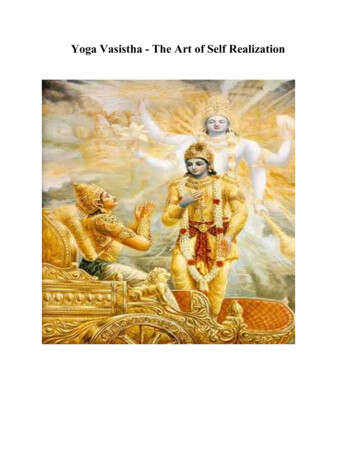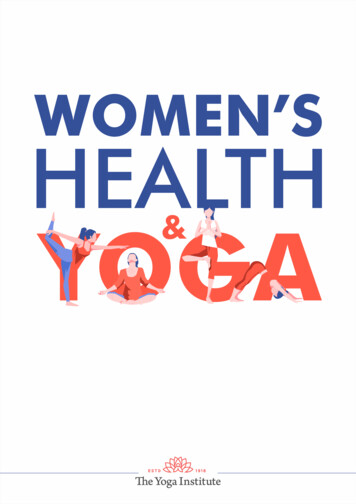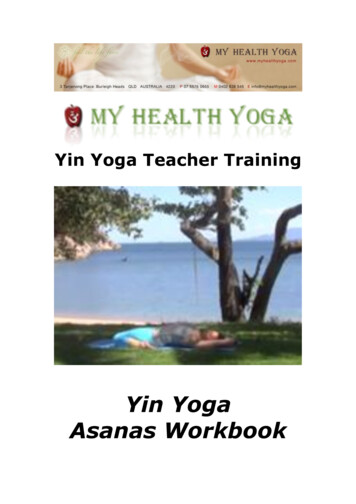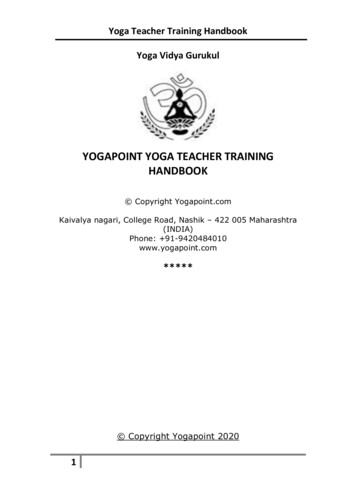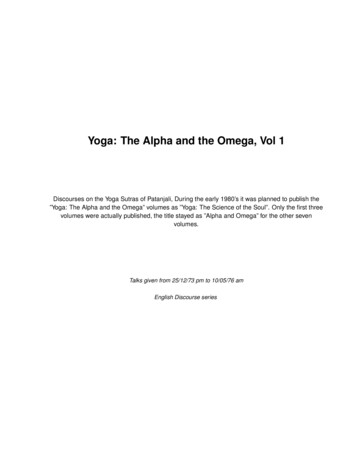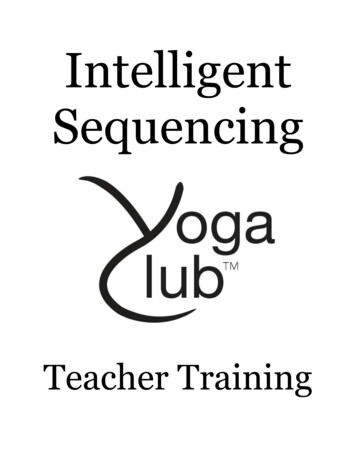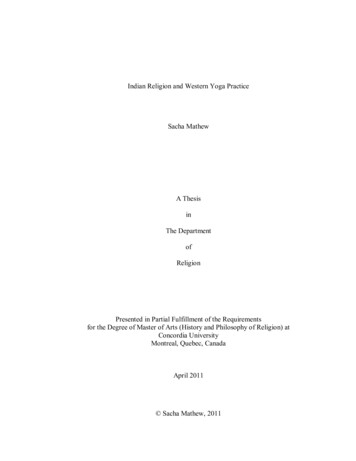
Transcription
Indian Religion and Western Yoga PracticeSacha MathewA ThesisinThe DepartmentofReligionPresented in Partial Fulfillment of the Requirementsfor the Degree of Master of Arts (History and Philosophy of Religion) atConcordia UniversityMontreal, Quebec, CanadaApril 2011 Sacha Mathew, 2011
CONCORDIA UNIVERSITYSchool of Graduate StudiesThis is to certify that the thesis preparedBy: Sacha MathewEntitled: Indian Religion and Western Yoga Practiceand submitted in partial fulfillment of the requirements for the degree ofMaster of Arts (History and Philosophy of Religion)complies with the regulations of the University and meets the accepted standards withrespect tooriginality and quality.Signed by the final Examining Committee:ChairExaminerDr. Michael OppenheimExaminerDr, Shaman HatleySupervisorDr.Leslie OrrApproved byDr. Lynda ClarkeChair, Department of Religion2011Brian LewisDean of Facultyii
ABSTRACTIndian Religion and Western Yoga PracticeSacha MathewYoga has become a very recognizable feature of Western culture. Almostevery person who has taken a yoga class can tell you that yoga originated in India.However, contemporary North American yoga – focused on postures and physicalpractice – departs considerably from “classical” yoga in India. The various yoga stylesand yoga studios in North America differ with respect to their relationship to the historyand tradition of yoga. My thesis seeks to understand the different ways that Indianreligion – “Indian-ness” and religiosity – are expressed in yoga classes and among yogapractitioners. This thesis is a case study conducted in Montreal carried out at three studiosrepresenting three styles that one could find in almost every major North American city:Sattva Yoga Shala (Ashtanga-Vinyasa Yoga), Moksha Yoga Montreal (hot yoga) andCentre de Yoga Iyengar de Montréal (Iyengar Yoga).At each studio I interviewed teachers and students to discover their experienceswith yoga, their beliefs about benefits from practicing yoga, as well as their knowledgeand relation to the tradition of yoga. Indian religious elements are present to varyingdegrees in North American yoga classes but both teachers and students appreciate theseaspects as pleasant exoticisms that are basically inessential to their yoga practice. At thesame time, students and teachers may be prone to projecting non-Indian spiritual ideasonto their yoga practice, which enhances its significance for them.iii
For My Beloved ParentsMr. George Mathew & Alice TherratilKanjooparamban"Speak the truth. Practice virtue. Do not neglect to study every day. Do notneglect Truth, virtue, studying or teaching Be one to whom your mother is God,your father is God, your teacher is God, a guest is like God Give withFaith.give freely, give with humility give with compassion This is thecommand. This is the teaching. This is the secret of the Veda "Taittiriya Upanisad I.11:1-6iv
Table of ContentsIntroduction . . 1Chapter 1: Yoga Studios and their Styles . . 8Moksha Yoga Montreal (Moksha Yoga) . 8Sattva Yoga Shala (Ashtanga Yoga) . 14Centre de Yoga Iyengar de Montréal (Iyengar Yoga) . 18Chapter 2: Yoga Teachers . 23Moksha Yoga teachers . 23Ashtanga Yoga teachers . 31Iyengar Yoga teachers . 39Chapter 3: Yoga Students . 47Moksha Yoga students . 47Ashtanga Yoga students . 53Iyengar Yoga students . 58Chapter 4: Conclusion . 65Lineage & Transmission of yoga . 65“Indian-ness” in Western yoga . 67Non-Hindu Religiousness in Western yoga . 72Bibliography . . 77Appendices . . 81v
IntroductionThese days everywhere you look you see yoga, from advertisements about yogurtto interactive videogames. Over the past twenty-five years yoga has been transformedfrom a sub-culture undercurrent to a staple of North American popular culture. Yoga hasbecome something of a big business of late, amid ever-growing claims of the benefits ofyoga from practitioners of all ages and like any product, yoga offers a variety of brandseach promoting various images and attracting different consumers. I became interested infinding out what kinds of yoga people are practicing and why, and about their attitudestoward and views on yoga. My aim in this thesis is to explore how different practitionersrelate to yoga and particularly to examine their sense of connection to yoga as atraditional Indian religious practice.As a yoga practitioner and teacher myself, I have had the good fortune to meet alarge variety of yoga practitioners with a wide range of views over the last many years.While from my perspective, there were a number of religious elements reflected in themilieu of the yoga class, most of the people I met did not feel that they were doinganything particularly religious when taking a class. In 2005, a friend and fellow yogateacher invited me to join him for a class at the newly opened Moksha Yoga studio inMontreal. My impressions of that class are what inspired me to undertake this study. Theroom was hot, it had mirrors, and it was filled with near naked people sweating profusely.At the very end of the class, after the teacher told us to lie down for final relaxation, sheuttered the Indian salutation “Namaste” and students responded likewise. Lying there inrelaxation my mind began to turn over the idea of “Indian-ness”. There was nothingparticularly Indian, Hindu or “traditional” about the class and yet the teacher found it1
necessary or significant to end with “namaste”, which evoked the class‟ response. Why?This thesis aims to answer this question, and, more broadly, the question of howpractitioners of modern Western yoga relate to its “traditional” roots.My primary research methods included both participant observation andinterviews. It was obvious to me that each of the various styles of yoga oriented itselfdifferently in relation to India and Hinduism. As this case study was to be conducted inMontreal, I purposefully chose three distinct styles that one could find in most majorNorth American cities: Sattva Yoga Shala (Ashtanga-Vinyasa Yoga), Moksha YogaMontreal (hot yoga) and Centre de Yoga Iyengar de Montréal (Iyengar Yoga). In each ofthese studios I attended numerous classes before introducing myself to any staff orstudents. After some weeks of participant observation in the classes I sought outparticipants for my interviews (see Appendix 1 for interview questions). The interviewswere all held in a public place, often the studio itself, and had an average duration of fiftyminutes. As I had been expecting a large difference between the opinions of students andteachers, I interviewed three of each at each studio. I chose teachers whose class I hadattended and, if possible, also interviewed the studio‟s owner and/or manager. I selectedthe students based on familiar faces; if I had seen a student a few times at the studio, Iwould then approach them to introduce myself and ask for an interview. As such, the mixof students was not directly determined by me. For example, the three Moksha studentsdid not turn out to represent the typical Moksha student. For the purpose of this thesis Ihave given all the participants pseudonyms. These are coded pseudonyms based on whichstyle a participant practices and if they are a teacher or student; for example AT2 is thesecond Ashtanga Yoga teacher and MS1 is the first Moksha Yoga student. I examined the2
data by themes according to responses to my interview questions and looked for patternsin responses among teachers and students respectively.In each studio participants ranged in ages and were of both sexes. Six out of theeighteen participants were male. While outnumbered by women, the proportion of onethird reflects the increasing number of male practitioners in recent years. The ages of theparticipants ranged from twenty-six to sixty-three years old and they had a wide range ofexperience in duration of practice or of teaching. As for myself, I am a Sivananda trainedyoga teacher who has been practicing yoga for the past seven years. If a participant askedme, I would share a little about myself with respect to yoga. It was obvious that Ipracticed yoga because I had met all participants in relation to a yoga class. I mustacknowledge one factor that may have had some influence on participants‟ responses thatis I am visibly South Indian. Participants largely enjoyed the interviews and for most itwas the first time they had reflected on any aspect of their practice.Despite the many myths shrouding yoga‟s origins, there is no question as to theimportance of the seminal work the Yogasutras of Patanjali. Dating the text isproblematic, due in part to the debate concerning whether the Patanjali of the Yogasutrasis the indentical to the author of the Mahabhasya commentary on Panini‟s grammar. S.Dasgupta proposes an origin date in the second century BCE (Dasgupta 1969, p.212),while other reasoned estimates span even to the fourth century CE (Larson 2009, p.488).Even if we could pinpoint the date of the Yogasutras, we must account for a long historyof development of thought leading up to Patanjali. This early development is “marked bythe fertile speculations expressed in” the Upanisads (Bryant 2009, p.xxi). One of thecentral sections of the Mahabharata is the Bhagavad Gita, which expounds the3
disciplines it names as Karma-yoga, Jnana-yoga and Bhakti-yoga. The Bhagavad Gitaremains an important text in modern Hindu devotionalism and also plays a role in modernWestern yoga, as we shall see. The Yogasutras presents four chapters consisting of onehundred and ninety-six aphorisms whose ultimate goal is Samadhi (liberation).According to Patanjali, liberation through yoga means the “cessation of mentalfluctuations” (YS 1:2) and that is achieved through the eight steps he lays out in histreatise. Those eights limbs are: Yamas (restraints), Niyamas (observances), Asana(posture), Pranayama (breath control), Pratyahara (withdrawal of the senses), Dharana(concentration), Dhyana (meditation) and Samadhi (superconscious state)). Interest inPatanjali‟s Yogasutras was renewed with Swami Vivekananda‟s 1896 Englishpublication of Raja-Yoga (De Michelis 2005, p.3). It was inspirational for modern Hindureform societies and also breathed new life into interest in yoga. Vivekananda himselfwas interested in Vedanta and God-realization and discouraged the practice of asanas –yoga postures (De Michelis 2005, p.164). Hatha-yoga is a sub-category of the larger yogasystem that employs practical methods to aid the journey toward the same goal. Hathayoga developed the use of asana (postures), pranayama (breath control) and kriya(purification) to prepare the body for later rungs of Patanjali‟s eight step ladder.In 1918 a dynamic and scholarly yogi began giving yoga demonstrations in India.He was Tirumalai Krishnamacharya (1888-1989) and between 1926 and 1946, he ran ayoga school in the Mysore palace under the patronage of the Maharaja (Mohan 2010, p.67). During this time he toured South India, often accompanied by accomplished youngstudents, demonstrating great physical feats of yoga (including stopping his pulse for twominutes). He taught many students during his long life, many of whom have become4
world renowned teachers themselves. It is largely thanks to his students that the physicalpractice of yoga – postural yoga - came to the West. Another important figure was SwamiSivananda of Rishikesh (1887-1963) who taught a mixture of neo-Vedanta, devotion andyoga in what he called the “Synthesis of Yoga”. His many students, most notably SwamiVishnudevananda and Swami Satchidananda, spread this polyvalent yoga throughout theworld. Both of these masters never left India but produced a well trained secondgeneration of international teachers who spread yoga all over the world.Yoga was born in a Hindu context. Although some early texts are available inEnglish translations, they do not exert a strong influence on the postural yoga practicedtoday. Apart from the previously mentioned Yogasutras and Bhagavad Gita, three textsconcerned specifically with Hatha-yoga retain some prominence: the HathayogaPradipika of Svatmarama, the Gheranda Samhita and the Siva Samhita. These three textsborrow heavily from one another; the oldest is the Hathayoga Pradipika from thefourteenth or fifteenth century, predating the other two by two or three hundred years(Eliade 1973, p.229). It should be noted that these texts are not given much attention bymodern practitioners of yoga despite offering relevant advice on postural yoga, unlike thetheistic Bhagavad Gita and the philosophical Yogasutras. Instead, the chief sources forcontemporary yoga practitioners in the West are the modern training manuals that havebeen continuously published since the 1960‟s.Before presenting the findings of my research, it is best to define a few keySanskrit terms used in my thesis. The most commonly used word is asana, whichtranslates as posture. It is the third of the eight steps of yoga practice set out by Patanjali.It also serves as a suffix to all Sanskrit names for postures, example: Garudasana or5
Mayurasana. Vinyasa refers to movements coordinated with one‟s breathing pattern. Thepractice of Pranayama refers specifically to manipulation of prana (vital energy), morepractically it means breath control or breathing exercises. A question I was concernedwith in this project is related to the Indian method of transmitting knowledge from master(guru) to disciple (shishya). The system that acts as an unbroken chain over generationsis called parampara (lineage) and implies the veneration not only of one‟s own guru butalso the gurus whose succession led to him. Lineage is also sometimes referred to assampradaya, which often traces its line to a mythological sage or deity as founder.There has always been some interest in the history of yoga as sub-category in thestudy of Indian religion. One of the earliest comprehensive studies of yoga is MirceaEliade‟s Le Yoga. Immortalité et Liberté (1954), which offered a wider scholarly lenswith which to examine yoga. More recently, the work of Elizabeth De Michelis and herstudent Mark Singleton have started to deal more directly with postural yoga. Mostscholarship on the subject preceding these texts have been historical in nature and sincemodern postural yoga is a relatively recent arrival on the scene, it has received littleattention as yet. De Michelis bridges this gulf with her book A History of Modern Yoga(2005) by introducing the revival of modern yoga with Vivekananda‟s Raja-Yoga (1896)and then jumping sixty years forward to the publication of Iyengar‟s Light on Yoga in1966. It is within those sixty years that the practice of postures comes not only to theforefront but nearly replaces other yogic practices. Singleton (2010) addresses thequestion of how that change happened, and astutely points out that postural yogadeveloped in relation to international trends in health culture. While De Michelis focuseson North America, Joseph Alter (2004) examines the development of postural yoga6
through this same period in India. These studies are starting to examine more carefullypostural practice rather than yoga as philosophy, which reflects contemporaryunderstandings and practice of yoga. It is in this context that my study may add toscholarship on the subject. My central concern has been with what yoga teachers andstudents have expressed to me about yoga. I believe that this focus gives a vivid pictureof the play between yoga and religion in a contemporary setting. It is interesting toconsider these dynamics against the backdrop of recent reports in the American mediaabout Hindu organizations wanting to “take back yoga” and in a society where religion isless and less overt. This study hopes to discover what people actually feel about whatthey are doing and what meanings yoga has for them.The first chapter of this thesis describes each of the three Montreal yoga studios Istudied: Moksha Yoga Montreal, Sattva Yoga Shala (Ashtanga) and the Centre de YogaIyengar de Montréal. The two main components of the data presented are theenvironment of the studios themselves and the character of the classes. Chapters two andthree are structured in the same way as each other with chapter two relating to theteachers‟ responses and chapter three to the students‟. Each of these two chapters isdivided into three sections. The first deals with participants‟ background, experience andattitude towards yoga. The second section explores responses about the benefits enjoyedby participants as a result of their yoga practice. The third section discusses participants‟knowledge of and interest in yoga‟s history and tradition. The fourth chapter offers myanalysis of the patterns and trends that have arisen from the participants‟ responses.Although many other interesting observations were made, I have focused my concluding7
analysis on the ways that practitioners‟ engagement with yoga reflect aspects of “Indianness” and religion.8
Chapter 1 Yoga Studios and their StylesThis chapter will describe the three Montreal yoga studios in detail, introducingthe three styles and giving an idea of the physical appearance of the studios. In addition,this chapter will discuss the methods used in the classes and the general tone of theclasses. Not only do these two elements mark the differences among the studios andstyles but more importantly indicates their Indian and/or spiritual orientation.Moksha Yoga Montreal (Moksha Yoga)Despite its relatively new arrival on the yoga scene, Moksha Yoga is among themost successful yoga styles. It was founded by Ted Grand and Jessica Robertson in 2005.Grand was originally a student and associate of Bikram Choudhury, the famous guru ofhot yoga based in California. Having decided to go his own way, Grand developed theMoksha sequence of postures and began opening franchise studio locations. TheMontreal Moksha studio is owned by the manager and Ted Grand. The influence of hisformer teacher is evident in the class and in his business model. Like Bikram Yoga,Moksha is practiced in a heated room. However, whereas Bikram was strict on postures,sequencing and teaching, Grand designed his system with greater freedom for bothteachers and students. Interestingly, the Sanskrit term moksha means freedom from thecycle of birth and death. However, Moksha Yoga offers a more modern and practicalfreedom; “freedom from letting work get to you, freedom from the frustration of traffic,or an argument, or from a need to fit a certain body image before accepting oneself [.]we share this term. because we see freedom in its varied shades as a worthy goal”(Grand and Robertson 2005, p.4).9
What is most particular is Grand‟s community focus through his studios. AllMoksha Yoga studios are required to offer a minimum of two “Karma classes” a week.These classes are given for a minimum donation of five dollars and the proceeds go tobenefit a local charity. The other significant focus of Moksha is its environmentaloutlook: “The studios are built with sustainable and non-toxic supplies, lights and heatingsystems are low consumption and all studios are cleaned with environmentally-friendlycleaning products” (http://www.mokshayoga.ca/au-philosophy.htm).There are two Moksha Yoga studios in Montreal; I attended classes at the StLaurent boulevard location. The studio itself is quite modern and chic looking. Whenentering, students are greeted at a small reception table with a little adjoining boutique.Students may rent any of the accessories necessary class including water bottle, towel oryoga mat. The changing rooms are fully equipped with showers and supplies. The decorof the studio is not overly eastern but it should be noted that several busts of the Buddhaare to be found in the reception area. Also, a framed map of ancient India is hung on thewall. The entire studio is quite clean, largely thanks to the trade program; students mayvolunteer three to four hours a week in exchange for free classes. It is worth noting thatmany yoga studios employ this sort of program under the name of “Karma-yoga” orselfless service; Moksha intentionally avoids the use of the term in favour of “trade”,which refers to a direct barter of service (unpaid work) for service (yoga classes). Bychanging the use of the term, the personal intention in the program changes from selflessservice (“Karma-yoga”) to selfish service (“trade”). The spiritual dimension of service isreplaced by more practical motivation. As previously mentioned, Moksha does use theterm “karma” but to designate their five dollar classes that aid local charities.10
The practice hall can fit approximately 50 students and is often at capacity. Infact, students often line up outside the studio awaiting the next class. This is particularlythe case with the two Karma classes on Friday evenings. The hallway was usually filledwith upward of 40 people, mostly university students, some sitting on the floor and somestanding but all talking excitedly. It was obvious that it was an activity to be done withfriends, not a solitary and contemplative practice. For many of the students, the Fridaynight class is a cheap and healthy way to feel great at the end of the week. Most forgetabout their week and after hitting the showers are ready for a night on the town, for whichthe studio is ideally located.The practice hall‟s front wall is entirely a full length mirror but without any otherdecoration or wall hangings inside. It is heated by overhead radiant heaters and therooms‟ temperature varies between 34 and 38 depending on the humidity and thenumber of bodies in the room. The manager also told me that it is hotter in the middle ofthe room and so often suggests newcomers stay closer to the outer part of the hall.Moksha offers 9 classes daily, more than any other studio in Montreal, and Moksha isopen 365 days a year without fail. The manager mentioned to me that they are in theprocess of expanding and are building an additional practice hall for even more classes,some of which will be taught French.The Moksha sequence has been published by the Montreal Moksha studio as TheLittle Moksha Yoga Book. It contains illustrations and explanations of 42 postures but italso notes that the “sequence is a set foundation that varies from teacher to teacher”(Grand and Robertson 2005, p.4). The general teaching style found at Moksha is fairlystandardized. The teachers do not follow an exact script but they often use similar11
language, always in a very soft tone. All the instructors adjust students‟ postures in thesame manner that is more like a massage than a correction. The basic structure of aMoksha class is a short initial relaxation, deep breathing, standing series, floor series andfinal relaxation. The aim of the sequence is to “stretch, strengthen and tone the muscleswhile detoxifying the body and calming the mind” (http://www.mokshayoga.ca/hywhat.htm). Another distinct aspect of the class is what is called “intention setting”; earlyin the class the teacher will ask students to a take a moment to mentally find their ownpersonal intention for their practice. The teacher will often suggest the intention directedtoward oneself, a family member or a loved one who is suffering or needs some positiveenergy. All classes are taught in English and Sanskrit names for postures are usedinfrequently.I took a number of classes at the studio, all of which were Moksha style. I mostlyattended the community classes, which are classes that allow newer teachers a chance forteaching experience. However, the class was often taught by more experienced teachers.Taking this class allowed me to experience a variety of teachers. In my experience theclasses generally start with students on their mats, all facing the mirrors. While somestudents do little warm-up stretches, some lie down on their back and others in child pose(sitting on their heels with their forehead on the ground and arms outstretched). It isusually quiet at this time before the class begins. The teacher enters and asks all studentsto take the child pose and “start connecting to your breath” through deep breathing.Students then come to stand at the front of their mats and are asked to set their intentionfor their practice. While standing, the class starts with six to eight Bikram style breaths:reaching your arms above your head while inhaling through the nostrils and lowering12
your arms in front of your body while exhaling through the mouth making a “Ha” sound.Moksha Yoga calls this breathing method by Patanjali‟s term “pranayama” but it is notone of the breathing exercises described in any of the classical Sanskrit Hatha-yoga texts.The early part of the class may be viewed as an introduction to the practice ofpostures. Following the first breathing exercise are the standing postures. Depending onthe teacher, the class would sometimes first do a few slow half sun salutations to movethe body a little before starting. The standing postures consist mostly of various lunges,squats, and side stretches punctuated by some standing forward bends. The standingseries gives a great deal of muscular work to the legs and hips. A few balancing postures(tree and eagle) are also added. From here a few seated postures are practiced; usuallyforward bends and twisting postures. The class then comes to lie on their mats facing theceiling. At this point, the teacher leads the class through several abdominal exercises.Here, no yogic postures are practiced only Pilates style core strength building. Then ontothe belly for a few back bends; the students turn again to face the mirrors. According toThe Little Moksha Yoga Book, the class ends (like a Bikram class) with kapalabhati,practiced while kneeling and sitting on the heels. kapalabhati is a kriya (cleansing)technique that consists of rhythmic forced exhalations by pumping the abdominalmuscles. It was not practiced in all the classes I attended and the method of how topractice it was never explained. The teachers simply called it “fire breath” or “cleansingbreath”. At the very end of the class the final relaxation is quite rushed. Students lie downagain on their backs, arms and legs apart, with eyes closed and try to rest and relax. Theteacher soon announces that “when it‟s your time to go, please do so quietly” and as soonas the teacher has given the word the race for the shower is on. Immediately the noise of13
people peeling their mats off the floor and rushing to the door washes over the fewstudents that remain on their backs. Within less than five minute only a handful ofstudents remain and they too are shooed away by the entrance of a volunteer pushing amop and bucket ready to prepare for the following class. The situation in the men‟schanging room is quite different from the experience of the female students. There areonly two showers for the men but seeing as there are never that many men in the classesthey won‟t be waiting too long. For the ladies however, there are three showers serving alot of women. I was told that tensions sometimes rise when dealing with the queue for theshower and if you take too long in the shower you may become the victim of some verbalabuse. Such was the case, as it was reported to me, for two young female students whowere taking their time, chatting and trading hair products, who were scolded by anenraged woman awaiting her turn for the shower.The majority of the classes are well attended and the studio seems to have ayoung student base. On the whole, Moksha‟s popularity is based on the fact that theyoffer a very contemporary style. The classes are fairly dynamic and postures are heldonly for an average of thirty seconds. Apart from Moksha style yoga, the studio alsooffers one Ashtanga class per week and a few Power Flow classes, which place moreemphasis on muscular training. The classes are all either an hour or an hour and a half.The convenience of the schedule is hard to beat; everyday classes follow one after theother from 7am till 10:30pm. Students come in, sweat for an hour with other almostnaked students, shower and then run off to continue their day. This is illustrated by thefact that the relaxation is right at end of the class, and most students head for the showersimmediately: Moksha Yoga is a busy studio for busy people.14
Sattva Yoga Shala (Ashtanga Yoga)Unlike Moksha Yoga, Ashtanga-Vinyasa Yoga (commonly known as AshtangaYoga) claims a long history rooted in ancient Indian practices. This dynamic and physicalstyle was founded by Sri K. Pattabhi Jois (1915-2009) of Karnataka state, in SouthernIndia. Although it is difficult to pinpoint the exact moment when the Ashtanga Yoga wefind today was crafted, two dates are of significance. First, in 1948 Jois founded in hisMysore home the Ashtanga Yoga Research Institute “with the aim of experimenting withthe curative aspect of yoga” (Jois, xviii). An extension, including a practice hall, was onlyadded to the house in 1964 (Jois, xviii). The second is 1962, which saw the Indianpublication of Jois‟ treatise Yoga Mala, written in the Indian language of Kannada. Thisis the only book published by Jois and outlines the philosophy a
Centre de Yoga Iyengar de Montréal (Iyengar Yoga). At each studio I interviewed teachers and students to discover their experiences with yoga, their beliefs about benefits from practicing yoga, as well as their knowledge and relation to the tradition of yoga



